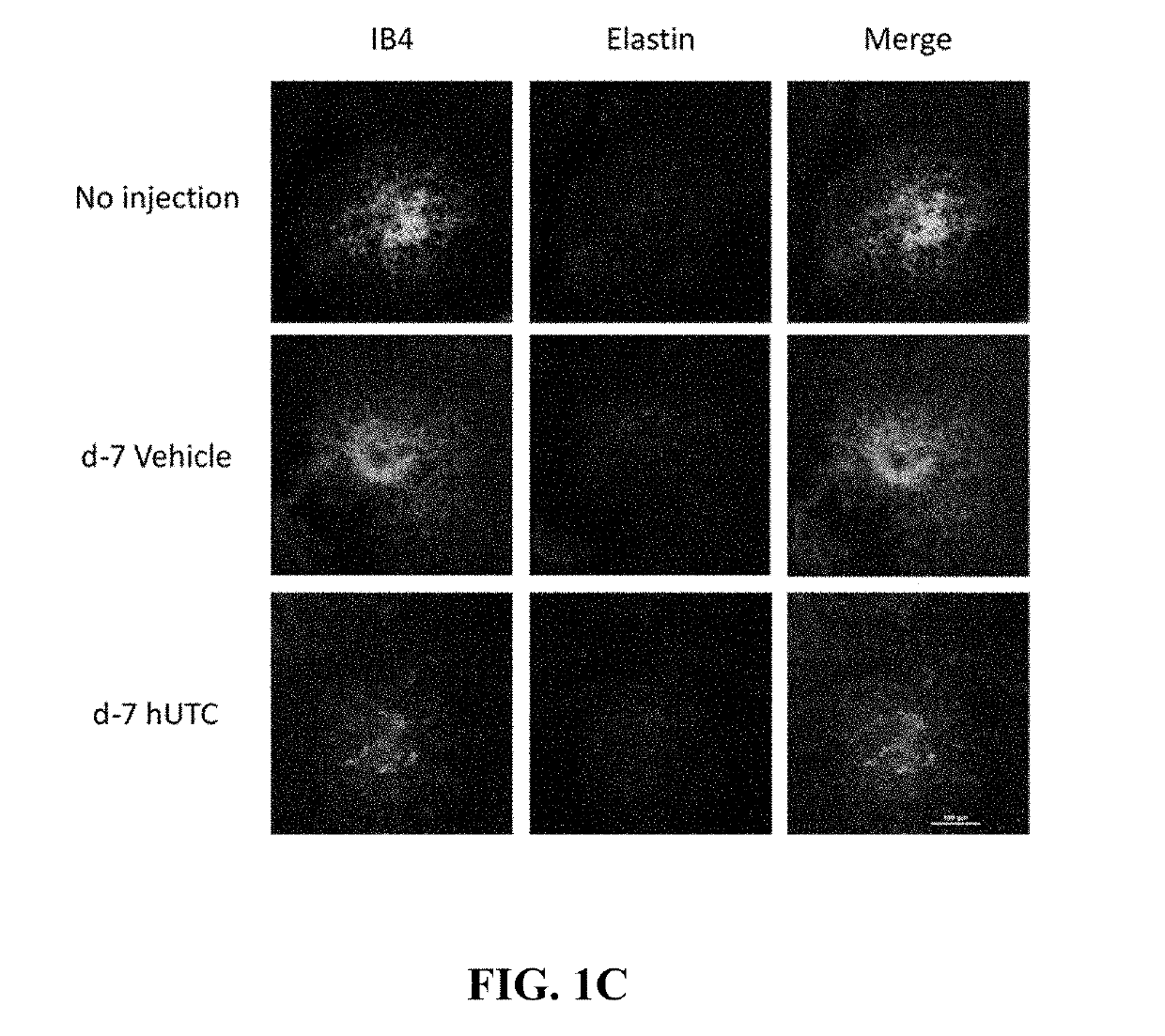Method of inhibiting angiogenesis
a technology of angiogenesis and angiogenesis, applied in the field of cell-based or regenerative therapy for ophthalmic diseases and disorders, can solve the problems of burdening patients, vision loss, undertreatment and subsequent vision loss, and achieve the effect of inhibiting or reducing retinal neovascularization and reducing neovascularization
- Summary
- Abstract
- Description
- Claims
- Application Information
AI Technical Summary
Benefits of technology
Problems solved by technology
Method used
Image
Examples
example 1
Effect of Human Umbilical Tissue-Derived Cells on Neovascularization
[0078]The effect of human umbilical tissue-derived cells on neovascularization and VEGF was examined.
[0079]Materials
[0080]VEGF ELISA kit was from Thermo Scientific (Pittsburgh, Pa.). sVEGFR1 and rat VEGF ELISA kits were from R&D Systems, Inc. (Minneapolis, Minn.). Recombinant human VEGF165 (a 165 amino acid splice variant of VEGF) was from EMD Chemicals (Gibbstown, N.J.). Halt Protease inhibitor Single-Use Cocktail was from Thermo Scientific (Pittsburgh, Pa.), and used at 1×, or 3× of the concentrations as instructed by the vendor. Anti-human VEGFR1 antibodies (AF321, BAF321) and normal goat IgG isotype control antibody were from R&D Systems (Minneapolis, Minn.). Recombinant human sVEGFR1 was from Cell Science (Canton, Mass.).
[0081]Methods
[0082]Animals and Treatments:
[0083]All procedures were performed with strict adherence to guidelines for animal use and experimentation.
[0084]Sub-Retinal Injections:
[0085]Six-week ...
example 2
Derivation of Cells from Postpartum Tissue
[0115]This example describes the preparation of postpartum-derived cells from placental and umbilical cord tissues. Postpartum umbilical cords and placentae were obtained upon birth of either a full term or pre-term pregnancy. Cells were harvested from five separate donors of umbilicus and placental tissue. Different methods of cell isolation were tested for their ability to yield cells with: 1) the potential to differentiate into cells with different phenotypes; or 2) the potential to provide trophic factors useful for other cells and tissues.
[0116]Methods & Materials
[0117]Umbilical Cell Isolation:
[0118]Umbilical cords were obtained from National Disease Research Interchange (NDR1, Philadelphia, Pa.). The tissues were obtained following normal deliveries. The cell isolation protocol was performed aseptically in a laminar flow hood. To remove blood and debris, the cord was washed in phosphate buffered saline (PBS; Invitrogen, Carlsbad, Calif...
example 3
Karyotype Analysis of Postpartum-Derived Cells
[0142]Cell lines used in cell therapy are preferably homogeneous and free from any contaminating cell type. Cells used in cell therapy should have a normal chromosome number (46) and structure. To identify placenta- and umbilicus-derived cell lines that are homogeneous and free from cells of non-postpartum tissue origin, karyotypes of cell samples were analyzed.
[0143]Methods & Materials
[0144]PPDCs from postpartum tissue of a male neonate were cultured in Growth Medium containing penicillin / streptomycin. Postpartum tissue from a male neonate (X,Y) was selected to allow distinction between neonatal-derived cells and maternal derived cells (X,X). Cells were seeded at 5,000 cells per square centimeter in Growth Medium in a T25 flask (Corning Inc., Corning, N.Y.) and expanded to 80% confluence. A T25 flask containing cells was filled to the neck with Growth Medium. Samples were delivered to a clinical cytogenetics laboratory by courier (estim...
PUM
 Login to View More
Login to View More Abstract
Description
Claims
Application Information
 Login to View More
Login to View More - R&D
- Intellectual Property
- Life Sciences
- Materials
- Tech Scout
- Unparalleled Data Quality
- Higher Quality Content
- 60% Fewer Hallucinations
Browse by: Latest US Patents, China's latest patents, Technical Efficacy Thesaurus, Application Domain, Technology Topic, Popular Technical Reports.
© 2025 PatSnap. All rights reserved.Legal|Privacy policy|Modern Slavery Act Transparency Statement|Sitemap|About US| Contact US: help@patsnap.com



